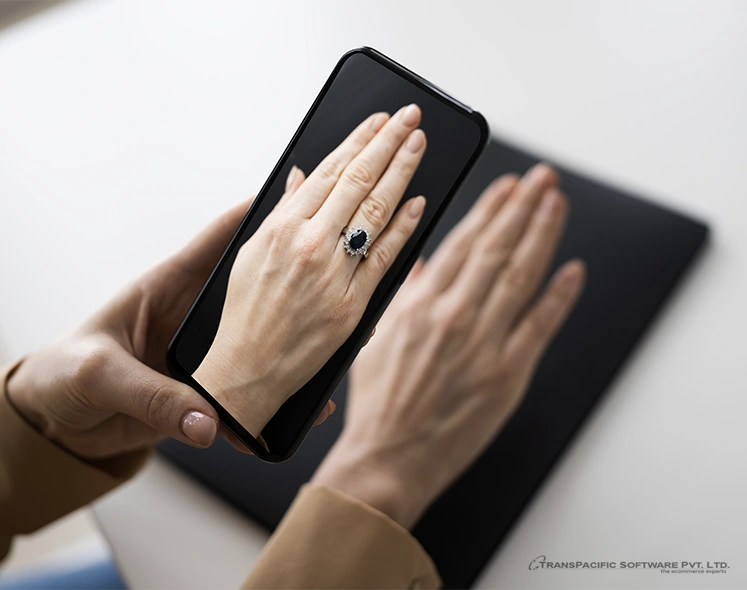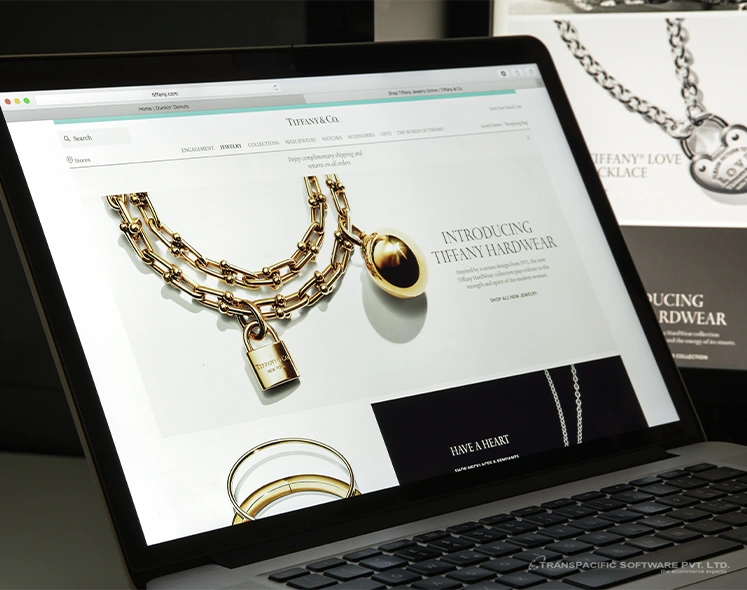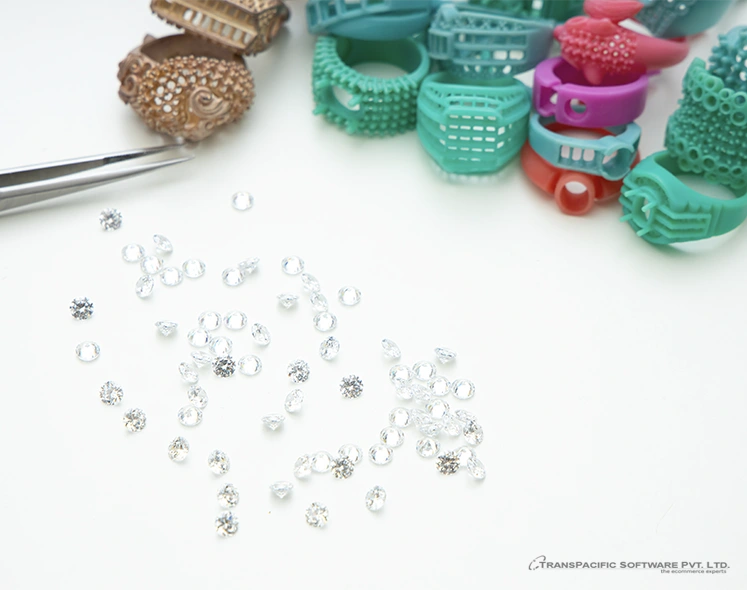Revolutionizing E-Jewelry Retail: AR, Blockchain & AI Transformations
The e-commerce landscape has witnessed significant transformations over the past few years, with the jewelry industry being no exception. The business that was once restricted to brick-and-mortar stores is now experiencing a wave of advancements that are democratizing access, boosting efficiency, and sparking customer engagement like never before. Technology is key to this transformation that is restructuring how jewelry businesses operate, interact with customers, and manage their supply chains. Without further ado, let's delve into the latest technological trends in the e-jewelry retail sector and ways in which groundbreaking innovations are influencing the industry.
Top Technological Trends in the Fine Jewelry Industry that are Revolutionizing the Retail Experience:
01) Augmented Reality (AR): Try Before You Buy, Virtually.

Why wonder or imagine if the piece of jewelry that looks interesting on your screen would look equally good on you when we now have AR to end the confusion and simplify things?
Augmented Reality has been revolutionary in the way customers can experience and interact with jewelry. One of the biggest challenges of online jewelry shopping has always been the inability to physically try on the pieces before making a purchase. You're merely at the mercy of your trust and hope. But with Augmented Reality, you can slip on a diamond ring or flaunt a pair of emerald earrings without ever stepping foot outside your home. AR-powered apps overlay digital jewelry models onto live camera feeds, allowing buyers to virtually "try on" pieces in real-time through their smartphones or other devices.
Thanks to AR, customers can now clearly understand how a particular piece of jewelry would look on them, experiment with styles, and evaluate whether it complements their features and skin tone. The increase in confidence helps boost online sales and lower the chances of returns, which usually happens because your expectations were not met.
02) Blockchain for Supply Chain Transparency: A New Era of Traceability
The fine jewelry industry has continuously been subjected to hard pressing questions on the ethical sourcing of materials, which often leads us to confront the dark underbelly of exploitation and environmental damage plaguing the supply chain. In this scenario, blockchain has emerged as a powerful tool to establish transparency.
This secure, decentralized ledger tracks the journey of each gem, from mine to retail, providing irrefutable proof of origin and ethical practices. Through blockchain, every stakeholder in the supply chain can now record and verify transactions. What does this mean for the customers? Unprecedented transparency and the power to make informed choices. The buyer can now trace the journey of their jewelry, ensuring it aligns with their values and isn't tainted by harmful practices.
At the end of the day, transparency builds trust, and informed buyers are more likely to spend on brands that share their values. This, in turn, incentivizes the entire industry to move towards ethical practices. It's a virtuous cycle that empowers consumers to drive positive change.

03) Artificial Intelligence (AI) for Personalized Recommendations

The one aspect of shopping that can make a world of difference is personalization; specifically, someone or something that not only remembers your preferences but also anticipates your desires. AI has already made this a reality. In the world of online jewelry, AI algorithms have the power to analyze customer preferences, purchase history, and browsing behavior to offer highly personalized product recommendations.
For example, if you've previously shown a preference for diamond solitaires, the AI might gently guide you to a collection of gorgeous diamond solitaire rings. It draws insights from your past choices and can even suggest complementary pieces, such as matching earrings or necklaces, creating a cohesive jewelry set personalized to your taste.
As you navigate through different categories, the AI continues to refine its understanding of your evolving preferences, making your online shopping experience truly immersive and rewarding. When it comes to customer retention and loyalty, AI-driven personalization has proven to be a powerful tool due to its ability to create a more engaging and tailored shopping journey.
05) Chatbots for 24/7 Customer Assistance
Imagine you're browsing an e-jewelry store, captivated by an exquisite diamond necklace; you’re bound to have questions on your mind. It could be about its craftsmanship, the certification of the diamond, or the refund policy on this expensive piece of jewelry. But instead of having to navigate through FAQs or wait for an email response, a Chatbot instantly appears on your screen to solve all queries.
This virtual assistant provides instant support, guides users through product selections, and ensures a seamless shopping experience. Because of Chatbots, customer assistance has undoubtedly undergone a paradigm shift, transitioning from reactive support to proactive engagement. While they are guiding shoppers, these AI-powered companions are also continuously gathering valuable data, which keeps customers coming back for more, thereby making Chatbots a game-changer for the future of online shopping.

06) 3D Printing for Unlocking Infinite Possibilities in Jewelry Manufacturing

This technological tool has shattered the mold in jewelry manufacturing quite literally, and by doing so, it has unleashed a surge of creative possibilities. For instance, latticework is defined by its delicate, interconnected patterns. Such designs are impossible to craft by hand. But 3D printing allows for utmost accuracy, enabling designers to push the boundaries of creativity to make truly unique and eye-catching pieces.
That’s not all; 3D printing also contributes to more sustainable jewelry practices by reducing material waste through its additive manufacturing process, where objects are built layer by layer. This reduces the need for subtractive techniques used in traditional methods like milling and casting. By blending creativity and sustainability, 3D printers have paved the way for a future where exquisite jewelry not only captivates with its intricate designs but also reflects responsible production.
Did You Know?
- As per a recent study by Shopify, approximately 72% of consumers would be willing to shop for jewelry online if they had the option to try it on virtually using AR.
- IBM's survey conducted in the year 2021 states that 66% of consumers are willing to pay more for products that can be traced back to their source through blockchain technology.
- According to Accenture's reports, personalization powered by AI can lead to approximately 20% increase in sales.
Parting Note
Indeed, AR, blockchain, and artificial intelligence have entirely reshaped the fine jewelry industry's landscape. In addition to improving the efficiency of the buying process, they are helping establish a deeper connection between customers and jewelry brands.
But while it may seem like technology's impact on e-jewelry retail has already come a long way, this is just the tip of the iceberg. The future holds the promise of even more innovative applications that will continue to revolutionize the way jewelry in bought and sold. Holographic displays, for instance, are a fine example of immersive product visualization. Imagine being able to rotate and inspect a piece of jewelry you like from all angles, just the way you would in a physical store. Like holographic displays, many more immersive experiences will open the door to a broader range of audiences and transform the very core of online shopping.
As businesses continue to leverage these advancements, the e-jewelry retail sector is poised for sustained growth, driven by a solid commitment to transparency, personalization, and exceptional customer experiences.


